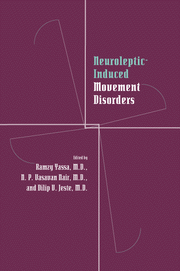Book contents
- Frontmatter
- Contents
- Contributors
- Preface
- Part I Historical perspective
- Part II Clinical aspects of tardive dyskinesia
- 2 Aging and tardive dyskinesia
- 3 Gender as a factor in the development of tardive dyskinesia
- 4 The Yale tardive dyskinesia study: a prospective incidence study among long-term outpatients
- 5 Vulnerability to tardive dyskinesia in schizophrenia: an exploration of individual patient factors
- 6 Tardive dyskinesia and affective disorder
- 7 Diabetes mellitus and tardive dyskinesia
- 8 Other factors in the development of tardive dyskinesia
- 9 Neuroleptic treatment and tardive dyskinesia
- 10 Anticholinergic drugs as factors in the development of tardive dyskinesia
- Part III Mechanisms underlying tardive dyskinesia
- Part IV Measurement of tardive dyskinesia
- Part V Tardive dyskinesia in different populations
- Part VI Other neuroleptic-induced movement disorders
- Part VII Treatment of tardive dyskinesia
- Index
2 - Aging and tardive dyskinesia
from Part II - Clinical aspects of tardive dyskinesia
Published online by Cambridge University Press: 09 October 2009
- Frontmatter
- Contents
- Contributors
- Preface
- Part I Historical perspective
- Part II Clinical aspects of tardive dyskinesia
- 2 Aging and tardive dyskinesia
- 3 Gender as a factor in the development of tardive dyskinesia
- 4 The Yale tardive dyskinesia study: a prospective incidence study among long-term outpatients
- 5 Vulnerability to tardive dyskinesia in schizophrenia: an exploration of individual patient factors
- 6 Tardive dyskinesia and affective disorder
- 7 Diabetes mellitus and tardive dyskinesia
- 8 Other factors in the development of tardive dyskinesia
- 9 Neuroleptic treatment and tardive dyskinesia
- 10 Anticholinergic drugs as factors in the development of tardive dyskinesia
- Part III Mechanisms underlying tardive dyskinesia
- Part IV Measurement of tardive dyskinesia
- Part V Tardive dyskinesia in different populations
- Part VI Other neuroleptic-induced movement disorders
- Part VII Treatment of tardive dyskinesia
- Index
Summary
Tardive dyskinesia, a syndrome of abnormal, involuntary body movements, is produced by administration of antipsychotic drugs. The movements can involve the face, lips, jaw, tongue, neck, trunk, upper extremities, and lower extremities. Less obvious internal body regions can also be involved, such as the muscles of respiration. “Dyskinesia” is a generic term, referring to excessive or abnormal movements of any etiology or character. Historically, it has been used predominantly to refer to choreoathetoid-type movements; more recently it has also been used to include tics, dystonia, akathisia, myoclonus, and ballismus. Although tremors are also, by definition, abnormal movements, they have traditionally been recorded as a separate form of movement disorder. When an antipsychotic drug is believed to be the cause of the dyskinesia, the term “tardive” is employed. When an antipsychotic drug is implicated in the appearance of tremors, the term “drug-induced parkinsonism” is used. In general, it has been the rule that at least 3 months of neuroleptic treatment should precede any attribution of these drugs as causative agents in the development of tardive dyskinesia (Schooler & Kane, 1982), although recent work with older individuals suggests that shorter exposure times may be sufficient. The abnormal movements themselves can be distinguished phenomenologically by their rhythmicity, speed, and repetition, as well as by the presence or absence of sustained postures at the termination of the movement. Combinations of different movements are frequently seen, with parkinsonism, choreiform dyskinesia, and akathisia being among the most common in elderly patients.
- Type
- Chapter
- Information
- Neuroleptic-induced Movement DisordersA Comprehensive Survey, pp. 13 - 25Publisher: Cambridge University PressPrint publication year: 1996
- 1
- Cited by

